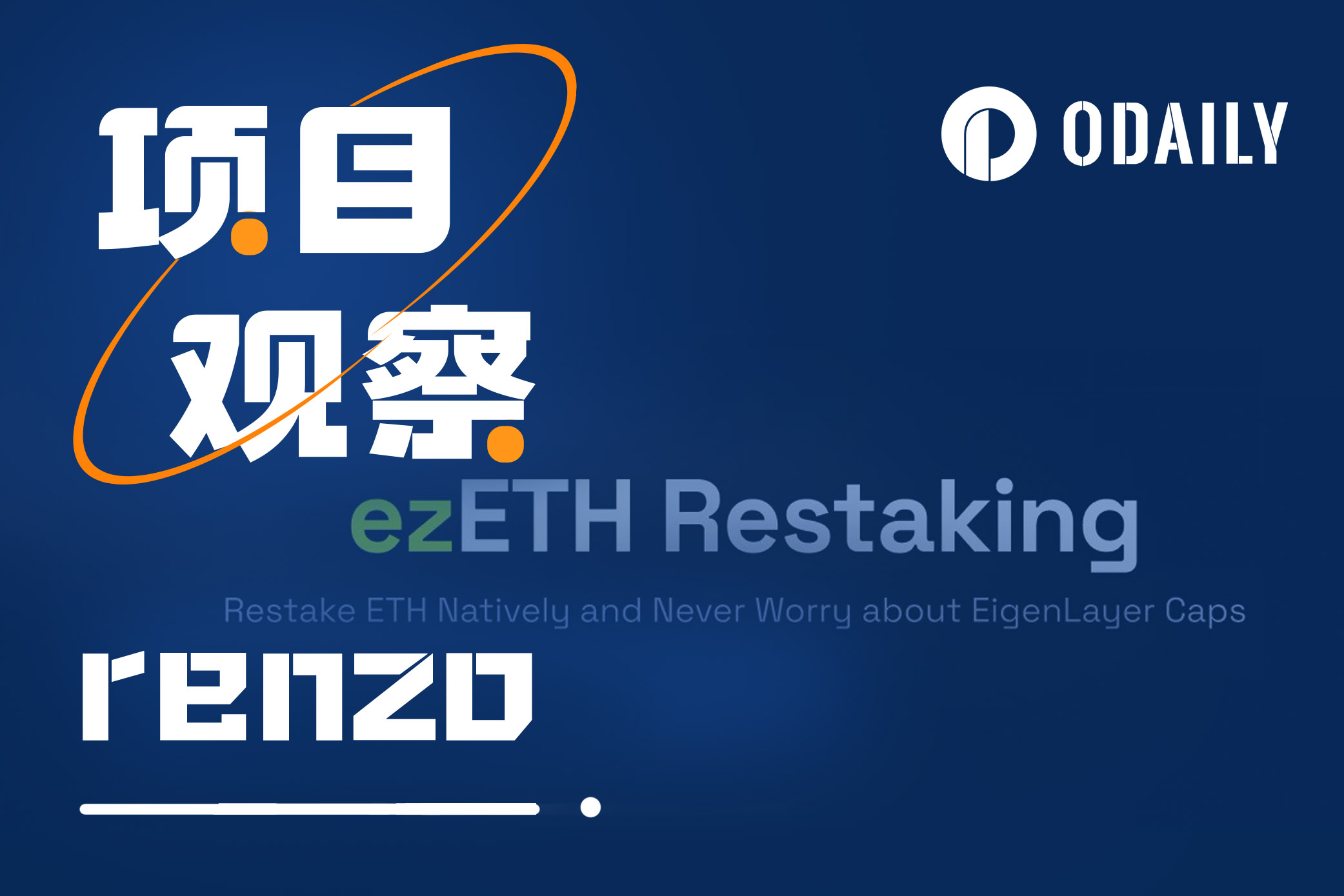Original - Odaily
Author - Nan Zhi

Restaking has undoubtedly been one of the hottest narratives of the past two years.
Ethereum head re-pledge protocolEigenLayer TVL exceeds 770,000 ETH, multiple opening deposit windows have reached the upper limit in a very short period of time. Renzo, a heavy-collateral protocol based on EigenLayer, has only been online for three months.TVL alone exceeds $100 million, and this growth was basically achieved in January this year.
What advantages does Renzo have to occupy a place on the Restaking circuit?
Restaking and EigenLayer
What is Restaking
The concept of Restaking was proposed by Eigenlayer founder Sreeram Kannan. Its core mechanism allows ETH and various types of LST to be pledged again on other protocols or chains and participate in their verification process. EigenLayer directly connects to the security and liquidity of Ethereum through Actively Validated Services (AVS), allowing users to enjoy the security of Ethereum without the need to establish a separate economic and verification system.
In a nutshell, EigenLayer is aToken Economic Security(cryptoeconomic security) rental market.
Token economic security (cryptoeconomic security) refers to the fact that in order to ensure effective operation while having permissionless and decentralized properties, each protocol requires network verifiers to participate in the project by pledging tokens. If the verifier fails If the contract is fulfilled, the pledged tokens will be slashed.
As a platform, EigenLayer raises assets from LSD holders on the one hand, and uses the raised LSD assets as collateral to provide convenient and low-cost AVS services to AVS demanders such as middleware, application chains, and Rollup. EigenLayer is a matching service provider and has a dedicated pledge service provider responsible for specific pledge security services.
The supply and demand sides of Restaking
Before the emergence of the Restaking model, if you want to achieve safe start-up and operation by building your own verification node network, you need to pay extremely high economic costs and time costs. The project party needs to establish a network and issue tokens at a high valuation to meet the verification requirements. In order to meet the demand for user rewards, validators need to invest in hardware and pledge initial tokens, which will result in a steady stream of incentive selling pressure.
Through Restaking, each protocol can reduce the cost of building a trust network by itself. Instead of building it themselves, they pay to purchase the assets and verifiers on EigenLayer. They can enjoy sufficient security at a low cost and can develop according to their own differences. According to the demand level of the stage, adjust the security level.
For LST (such as stETH, rETH, cbETH, etc.) providers, through EigenLayer, when receiving native staking rewards, they can also obtain a new layer of rewards from the business demand side.
Renzo
Whats wrong with EigenLayer?
EigenLayer uses LST as collateral to provide protection for AVS. But this does not mean that AVSs verification service can provide andEthereum-like security. Ethereums strong security is provided by its huge number of nodes and ETH pledge amount. However, the verification services purchased by business demanders from EigenLayer, the number of nodes and the amount of pledges cannot reach the same level as Ethereum. In short, what EigenLayer providesSecurity is limited。
In addition, the Renzo white paper points out that EigenLayer also facesThe problem of allocation strategy:
Users need to decide to protect one or more combinations of many AVS. The ideal situation is that users can protect 100% of all AVS, the operator behaves honestly, and the risk of slashing is the lowest. However, to build a robust restaking system, restakers must be able to quantify slashing risk and choose to protect certain more advantageous AVS while reducing participation in other less attractive AVS.
Renzo assumed a scenario with only 3 AVS, then there would be 7 allocation strategies:
① Only protect AVS A; ② Only protect AVS B; ③ Only protect AVS C; ④ Protect AB at the same time; ... ⑦ Protect ABC at the same time
With the increase of AVS, the choices will grow exponentially. With only 15 AVS running on EigenLayer, there are 32,767 possible strategies. There are also a variety of factors to consider, including scaling requirements, security audits of AVS, the economic model of AVS itself, etc.
How to solve Renzo
Renzo said, which abstracts the complex process of restaking for end-users, and restakers do not have to worry about the active selection and management of operators and reward strategies.
Renzo divides the risks of AVS into two categories, penalty risk and liquidity risk, and uses quantitative calculations to construct investment portfolios.
Slashage risk: Calculate the maximum loss (MaxLoss) to protect one or more AVS. The higher the maximum loss, the greater the strategy risk. Help determine the additional risk of protecting a new AVS, or weigh the choice of one AVS over another with greater risk.
Liquidity risk: Renzo defines a risk-adjusted incentive ratio (RAR), calculated by calculating staking rewards, base spend, and maximum losses. Similar to Sharpe ratio, which calculates the return and risk of an investment to evaluate the performance of the investment, users will want to maximize the RAR of the portfolio and allocate more funds to AVS that improves the RAR (i.e., provides higher returns and lower slashing risk).
Renzo said that more details will be released in a follow-up document, but they are not public yet.
Financing situation
A week ago, EigenLayer ecological liquidity re-pledge agreement Renzo announced the completion$3.2 million in seed round financing, Maven 11 led the investment, with participation from SevenX Ventures, IOSG Ventures, Figment Capital, Bodhi Ventures, OKX Ventures, Mantle Ecosystem, Robot Ventures, Paper Ventures and others. According to OKX Ventures,This is its first officially announced investment project in the EigenLayer ecosystem.。
Points program
On January 4, Renzo announced that it hadLaunched points program Renzo ezPoints. ezPoints is designed to reward users who contribute to the protocol. The first way to obtain points is to mint ezETH. ezETH is Renzo’s liquidity re-pledge token. It automatically obtains rewards and ensures liquidity. ezETH allows users to participate in DeFi while Keep the re-staking rewards. Users who provide ezETH liquidity to DEX will also receive additional multiplier rewards of ezPoints.
In addition, Renzo said that EigenLayer has an amount of LST deposits online, but there is no limit on native ETH deposits, but it is difficult for most users to obtain because it requires users to have 32 ETH and run an Ethereum node integrated with EigenLayer to run EigenPods.There is no upper limit for depositing tokens in Renzo., which has also become one of the main factors for Renzo TVL’s surge.
in conclusion
EigenLayer was completed in March last year$50 million Series A financing, each round of deposit quota opening also quickly reached the hard limit. The unlimited deposits provided by Renzo provide users with a smooth way to participate and receive multiple points rewards from EigenLayer and Renzo at the same time. On the other hand, EigenLayer will not start protecting AVS until mid-2024, and its specific operating processes and details still need to be further explored; Renzo provides practical application logic and methods for Restaking on the most fundamental issue of token economic security distribution guidance.



